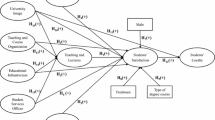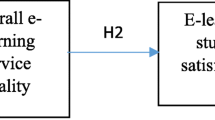Abstract
Customer loyalty is widely accepted as a critical factor in the long-term success of a service organization. This study develops a model of information cascades-based student loyalty (ICSL) by embedding information cascades in the context of educational services with insight from more traditional educational research. In the ICSL model, student loyalty is influenced directly by the perceived quality of teaching services (QTS), the perceived signal of retention (PSR), and the perceived quality of administrative services (QAS), while also being influenced indirectly by QTS, QAS, and perceived others’ retention via the mediation of PSR. This study tests the ICSL model using the structural equation modeling approach, implementing empirical data from a survey done on a large private university in Taiwan. The test results reveal that PSR is significantly influenced by QTS, QAS, and perceived others’ retention. Accordingly, the influence of QAS on student loyalty is insignificant, while the influences of QTS and PSR on student loyalty are conversely significant. Finally, implications are also discussed.
Similar content being viewed by others
References
Anderson J.C., Gerbing D.W. (1988). Structural equation modeling in practice: a review and recommended two-step approach. Psychological Bulletin 103(3): 411–423
Bentler P.M. (1989). EQS Structural Equations Program Manual. Los Angeles, BMDP Statistical Software
Bhattacherjee A. (2001). Understanding information systems continuance: An expectation-confirmation model. MIS Quarterly 25(3): 351–370
Bikhchandani S., Hirshleifer D., Welch I. (1992). A theory of fads, fashion, custom and cultural change as informational cascades. Journal of Political Economy 100(5): 992–1026
Bikhchandani S., Hirshleifer D., Welch I. (1998). Learning from the behavior of Conformity, fads, and informational cascades. The Journal of Economic 12(3): 151–170
Boulding W., Kalra A., Staelin R., Zeithaml V.A. (1993). A dynamic process model of service quality: From expectations to behavioral intentions. Journal of Marketing Research 30(1): 7–27
Choudhury V., Hartzel K.S., Konsynski B.R. (1998). Uses and consequences of electronic markets: An empirical investigation in the aircraft parts industry. MIS Quarterly 22(4): 471–507
Coates H. (2005). The value of student engagement for higher education quality assurance. Quality in Higher Education 11(1): 25–36
Darlaston-Jones D., Pike L., Cohen L., Young A., Haunold S. (2003). Are they being served? Student expectations of higher education. Issues in Educational Research 13(1): 31–52
Deephouse D.L. (1996). Does isomorphism legitimate?. Academy of Management Journal 39(4): 1024–1039
DiMaggio P.J., Powell W.W. (1983). The iron cage revisited: institutional isomorphism and collective rationality in organizational fields. American Sociological Review 48(2): 147–160
Hatcher L. (1994). A Step-by-Step Approach to Using the SAS System for Factor Analysis and Structural Equation Modeling. Cary, NC: SAS Institute Inc.
Haveman H.A. (1993). Follow the leader: Mimetic isomorphism and entry into new markets. Administrative Science Quarterly 38(4): 593–627
Hennig-Thurau T., Langer M.F., Hansen U. (2001). Modeling and managing student loyalty: An approach based on the concept of relationship quality. Journal of Service Research 3(4): 331–344
Hooley G.J., Lynch J.E. (1981). Modeling the student university choice process through the use of conjoint measurement techniques. European Research 9(4): 158–170
Kotler P., Fox K.F.A. (1995). Strategic Marketing for Educational Institutions. Englewood Cliffs, New Jersey: Prentice Hall Inc.
Lee J. (2003). An end-user perspective on file-sharing systems. Communications of the ACM 46(1): 49–53
Lin C.P., Ding C.G. (2005). Opening the black box: Assessing the mediating mechanism of relationship quality and the moderating effects of prior experience in ISP service. International Journal of Service Industry Management 16(1): 55–80
Marks G.N. (1999). Early School Leaving in Australia: Findings from the 1995 Year 9 LSAY cohort, Research Report No. 11. Melbourne, Council for Educational Research
Marsh H. (1987). Students’ evaluation of university teaching: Research findings, methodological issues, and directions for future research. International Journal of Educational Psychology 11(2): 253–288
Marsh H. (1991a). Multidimensional students’ evaluations of teaching effectiveness: A test of alternative higher order structures. Journal of Educational Psychology 83(2): 285–296
Marsh H. (1991b). A multidimensional perspective on students’ evaluations of teaching effectiveness: Reply to Abrami and d’Apollonia. Journal of Educational Psychology 83(3): 416–421
Martinez P. (2001). Improving Student Retention and Achievement: What do we Know and What do we Need to Find Out?. London, Learning and Skills Development Agency
Mashburn A.J. (2000). A psychological process of college student dropout. Journal of College Student Retention 2: 173–190
Mols N.P. (1998). The behavioral consequences of PC banking. International Journal of Bank Marketing 16(5): 195–201
Muse W.V., Burkhalter B.B. (1998). Restructuring brings quality improvements to Auburn University. Total Quality Management 9(4/5): 177–183
Reynolds N., Diamantopoulos A., Schlegelmilch B.B. (1993). Pretesting in questionnaire design: A review of the literature and suggestions for further research. Journal of the Market Research Society 35(2): 171–182
Rowley J. (1998). Quality measurement in the public sector: Some perspective from the service quality literature. Total Quality Management 9: 321–335
Rumberger R.W. (2003). The causes and consequences of student. Journal of Negro Education 72(1): 6–21
Song J., Walden E.A. (2003). Consumer behavior in the adoption of peer-to-peer technologies: An empirical examination of information cascades and network externalities. In Proceedings of the 9th Americas Conference on Information Systems (AMCIS), Tampa, Florida, USA, pp. 1801–1810
Tingling P., Parent M. (2003). Mimetic isomorphism and technology evaluation: Does limitation transcend judgment?. Journal of the Association for Information Systems 3(1): 113–143
Vélez W., Saenz R. (2001). Toward a comprehensive model of the school leaving process among Latinos. School Psychology Quarterly 16(4): 445–467
Wang C.C., Hsu Y.H., Fang W.C. (2004). Acceptance of technology with network externalities: An empirical study of Internet instant messaging services. Journal of Information Technology Theory and Application 6(1): 15–28
Waugh R.F. (2002). Academic staff perceptions of administrative quality at universities. Journal of Educational Administration 40(2): 172–188
Woodard D. Jr., Love P., Komives S. (2000). Leadership and Management Issues for a New Century. New Directions for Student Services, No. 92. San Francisco, Jossey-Bass
Author information
Authors and Affiliations
Corresponding author
Rights and permissions
About this article
Cite this article
lin, Cp., Tsai, Y.H. Modeling Educational Quality and Student Loyalty: A Quantitative Approach Based on the Theory of Information Cascades. Qual Quant 42, 397–415 (2008). https://doi.org/10.1007/s11135-006-9051-5
Published:
Issue Date:
DOI: https://doi.org/10.1007/s11135-006-9051-5




